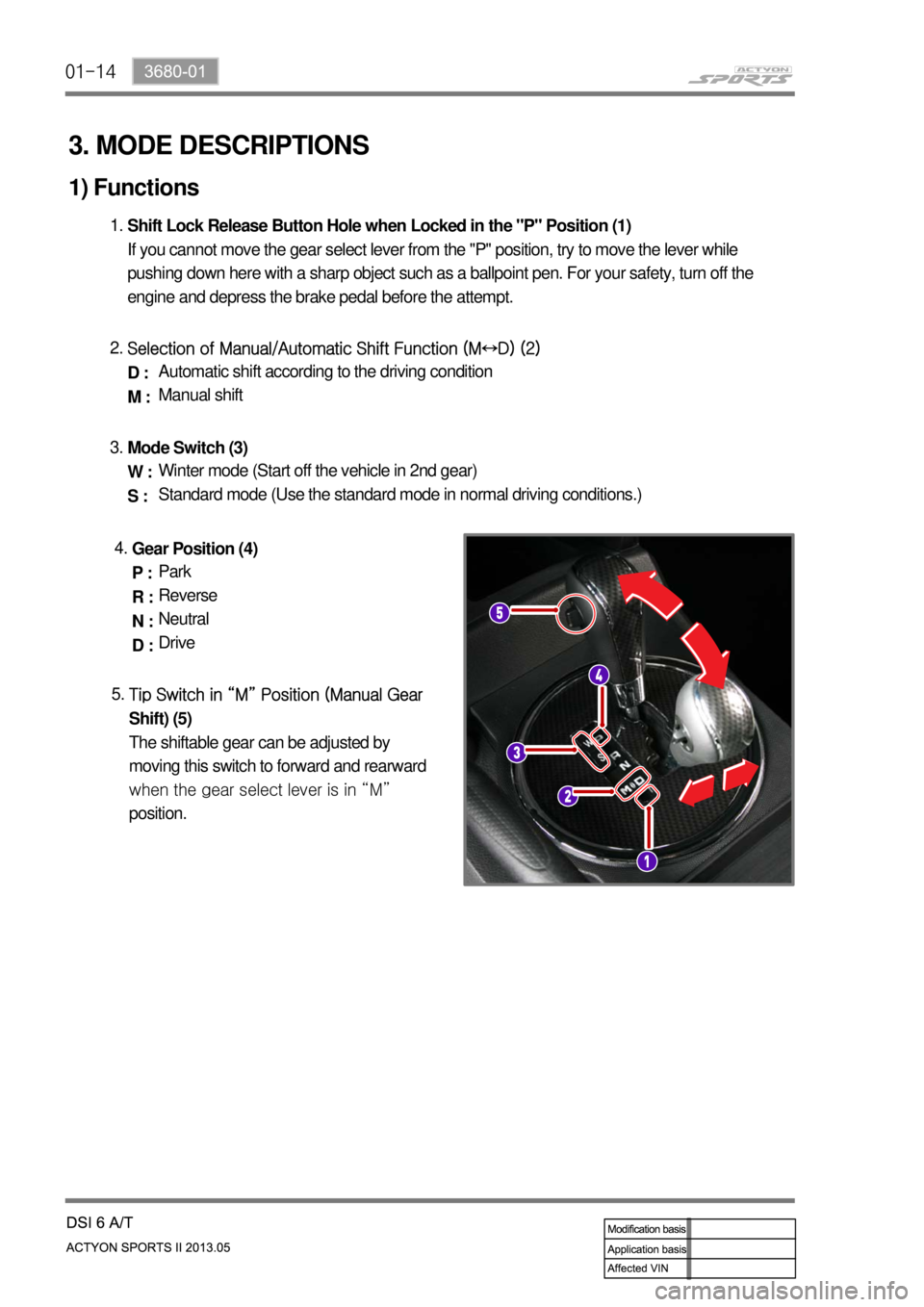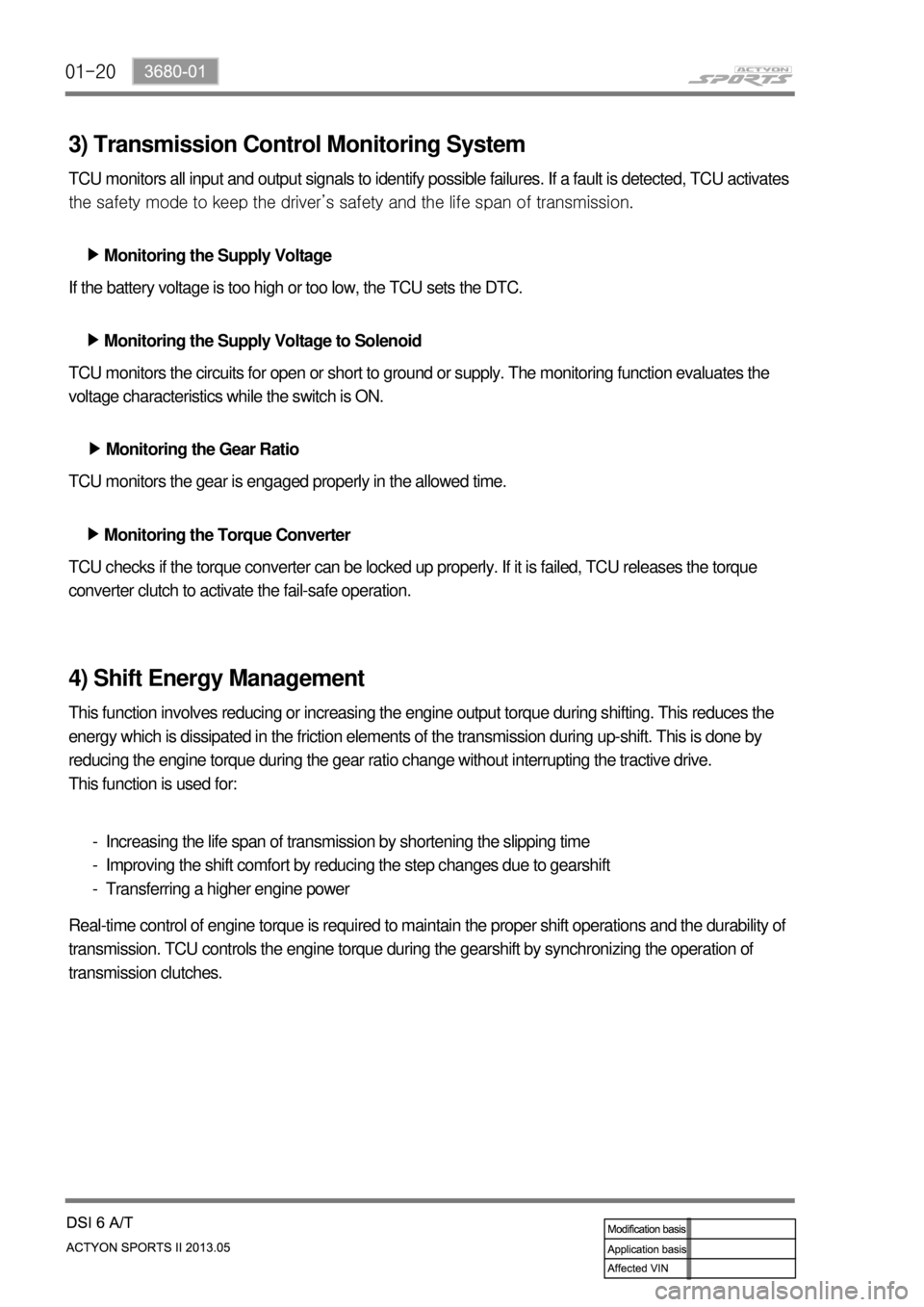2013 SSANGYONG NEW ACTYON SPORTS lock
[x] Cancel search: lockPage 450 of 751

01-4
This indicator shows the current position of the
gear.
In normal mode: P, R, N, D
Gear indication in “M” mode: 1, 2, 3, 4, 5, 6
Driving gear can be adjusted by operating the
tip switch after moving the gear select lever in
“M” position.
Shift down Shift up
Tip switch on steering wheel ▶
Gear position display on instrument
cluster ▶
Gear select lever ▶
Mode Switch
W :
S :
Selection of Manual/
Automatic Shift Function
D :
M :Shift Lock Release Button Hole
when Locked in the "P" Position
If you cannot move the gear select
lever from the "P" position, try to
move the lever while pushing down
here with a sharp object such as a
ballpoint pen. For your safety, turn
off the engine and depress the
brake pedal before the attempt. Tip Switch in “M” Position (Manual Gear Shift)
The shiftable gear can be adjusted by moving this switch to forward and rearward when the gear
select lever is in “M” position.
Positions of gear
select lever
P : Parking
R : Reverse
N : Neutral
D : Drive
Winter mode
Standard mode (Use the
standard mode in normal
driving conditions.)
Automatic shift according to
the driving condition
Manual shift
Page 455 of 751

01-93680-01
3. TIGHTENING TORQUE
Description Size x Numbers Tightening torque
Transfer case housing M12 x 32 54 ~ 68
Etension housing M12 x 32 54 ~ 68
Oil pan M6 x 16 4 ~ 6
Valve body to transmission housing M6 x 26 8 ~ 13
Valve body to transmission housing M6 x 45 8 ~ 13
Center support to transmission housing M10 x 34 20 ~ 27
Output shaft locking nut M24 x 15 100 ~ 110
Pump cover to oil pump M8 x 55 24 ~ 27
Pump cover to transmission housing M8 x 40 24 ~ 34
Pump cover to transmission housing M8 x 58 24 ~ 34
Upper valve body to lower valve body M6 x 30 15 ~ 17
Detent spring M8 x 16 20 ~ 25
Variable bleed solenoid and speed sensor
M4 x 12 2.8 ~ 3.2
Transmission oil level plug 30 ~ 35
Front cooling lines to transmission cooler
25 ~ 35
Rear cooling lines to transmission cooler
25 ~ 35
Drive plate to torque converter
40 ~ 42
Gear select lever to shaft rod
14 ~ 20
Page 457 of 751

01-113680-01
1. OVERVIEW
The six speed automatic (M78) transmission is
available in two variants: four wheel drive and
two wheel drive.
The transmission has the following features:
Six Forward Speeds
One reverse gear
A torque converter with an integral converter lock-up clutch
Electronic shift and pressure controls
A single planetary gear-set
A double planetary gear-set
Two hydraulically controlled brake bands
Three multi-plate clutches
All hydraulic functions are directed by electronic solenoids to control: -
-
-
-
-
-
-
-
-
Engagement feel
Shift feel
Shift scheduling
Modulated torque converter clutch applications ·
·
·
·
The transmission contains fully synthetic automatic transmission fluid (ATF) and is filled for life; therefore
it does not require periodic servicing.
Engine power reaches the transmission via a torque converter with integral converter lock-up clutch.
The six forward gears and one reverse gear are obtained from a single planetary set, followed by a
double planetary set. This type of gear-set arrangement is commonly known as Lepelletier type gear-set.
The automatic transmission is electronically controlled. The control system is comprised of the following
elements:
External transmission control unit (TCU)
Internal embedded memory module (EMM)
Input and output speed sensors
Valve body unit comprised of four on/off solenoid valves and six variable bleed solenoids
Torque converter -
-
-
-
-
Page 458 of 751

01-12
2. FEATURES
Early Downshifts with Hard Braking and Skip Shifts ▶
When heavy braking is detected, the transmission downshifts early and skips gears to provide increased
engine braking to provide gear selection for tip-in.
Gear Hold on Uphill/Downhill ▶
If the accelerator pedal is released when travelling uphill, upshifts are prevented to reduce busyness on
grades. If the accelerator pedal is released when travelling downhill, upshifts are prevented to enhance
engine braking.
Soft Engagement when Shifting to “D” and “R” Position ▶
A soft engagement feature avoids harsh take up of drive when selecting Drive or Reverse. This is
achieved by limiting engine speed and engine torque which results in a rapid, but progressive
engagement of either Drive or Reverse when moving from the Park or Neutral positions. There is no
drive engagement prevention strategy implemented on the transmission system as there is sufficient
engine strategy to protect the system. However, reverse gear engagement is prevented until engine
speed is less than 1400 rpm and the accelerator pedal position is less than 12% and vehicle speed is
less than 10 km/h.
Converter Clutch Lock-Up In All Gears ▶
The transmission features converter clutch lock-up in all gears. This feature provides improved fuel
economy and vehicle performance. It also improves transmission cooling efficiency when towing heavy
loads at low speeds, e.g. in city driving or hill terrain.
Embeded Memory Module (EMM) ▶
The embedded memory module (EMM) is
matched to the transmission's valve bodies
during transmission assembly to ensure refined
shift quality. The EMM is integrated into the input
speed sensor which is mounted on the valve
body in the transmission. The EMM is used to
store data such as valve body calibration data
and valve body serial number. Upon installation,
the TCU will download the data from the EMM
and utilise this data in the operation of the
transmission.
1) Features
Page 459 of 751

01-133680-01
2) Cooling System
The transmission cooling system ensures rapid warm-up and constant operating temperature resulting
in reduced fuel consumption and refined shift quality.
It also includes a cooler by-pass within the hydraulic system to allow sufficient cooling and lubrication to
the transmission drivetrain in the event of a blockage in the transmission cooler.
Gear Shift ▶
Coastdown ▶
Torque Demand ▶ Transmission gear change is controlled by the TCU. The TCU receives inputs from various engine and
vehicle sensors to select shift schedules and to control the shift feel and torque converter clutch (TCC)
operation at each gear change
Coastdown downshifts occur at 0% accelerator pedal when the vehicle is coasting down to a stop. To
reduce the shift shock and to improve the shift feeling during downshift, TCU electronically controls the
transmission.
Torque demand downshifts occur (automatically) when the driver demand for torque is greater than the
engine can provide at that gear ratio. If applied, the transmission will disengage the TCC to provide
added acceleration.
3) Shift Strategy
Page 460 of 751

01-14
3. MODE DESCRIPTIONS
1) Functions
Tip Switch in “M” Position (Manual Gear
Shift) (5)
The shiftable gear can be adjusted by
moving this switch to forward and rearward
when the gear select lever is in “M”
position. 5.Shift Lock Release Button Hole when Locked in the "P" Position (1)
If you cannot move the gear select lever from the "P" position, try to move the lever while
pushing down here with a sharp object such as a ballpoint pen. For your safety, turn off the
engine and depress the brake pedal before the attempt. 1.
Gear Position (4)
P :
R :
N :
D : 4.Mode Switch (3)
W :
S : 3.Selection of Manual/Automatic Shift Function (M↔D) (2)
D :
M : 2.
Automatic shift according to the driving condition
Manual shift
Winter mode (Start off the vehicle in 2nd gear)
Standard mode (Use the standard mode in normal driving conditions.)
Park
Reverse
Neutral
Drive
Page 466 of 751

01-20
3) Transmission Control Monitoring System
TCU monitors all input and output signals to identify possible failures. If a fault is detected, TCU activates
<009b008f008c0047009a0088008d008c009b00a0004700940096008b008c0047009b009600470092008c008c00970047009b008f008c0047008b00990090009d008c009902c5009a0047009a0088008d008c009b00a0004700880095008b0047009b008f00
8c004700930090008d008c0047009a00970088009500470096>f transmission.
Monitoring the Supply Voltage ▶
Monitoring the Supply Voltage to Solenoid ▶
Monitoring the Gear Ratio ▶
Monitoring the Torque Converter ▶ If the battery voltage is too high or too low, the TCU sets the DTC.
TCU monitors the circuits for open or short to ground or supply. The monitoring function evaluates the
voltage characteristics while the switch is ON.
TCU monitors the gear is engaged properly in the allowed time.
TCU checks if the torque converter can be locked up properly. If it is failed, TCU releases the torque
converter clutch to activate the fail-safe operation.
4) Shift Energy Management
This function involves reducing or increasing the engine output torque during shifting. This reduces the
energy which is dissipated in the friction elements of the transmission during up-shift. This is done by
reducing the engine torque during the gear ratio change without interrupting the tractive drive.
This function is used for:
Increasing the life span of transmission by shortening the slipping time
Improving the shift comfort by reducing the step changes due to gearshift
Transferring a higher engine power -
-
-
Real-time control of engine torque is required to maintain the proper shift operations and the durability of
transmission. TCU controls the engine torque during the gearshift by synchronizing the operation of
transmission clutches.
Page 467 of 751

01-213680-01
Pressure Modulation ▶
To provide a higher level of shift comfort and durability, the hydraulic pressure in the shift related friction
elements of the transmission must be matched accurately to the input torque to transmission. This
hydraulic pressure is composed of a hydraulically pre-set basic pressure and a control pressure which is
set by one of the variable bleed solenoids.
The transmission input torque can be directly calculated from the following operating parameters:
engine torque signals
engine speed or any signal transmitted from ECU through CAN lines
converter slip -
-
-
Separate pressure characteristics for each gear change make it possible to adapt precisely to the
particular shift operation.
5) Shift Mode Selection by TCU
The driver can select Standard (S) or Winter mode (W) with the mode switch. TCU automatically
changes the shift mode according to the transmission oil temperature, uphill or downhill gradient, and
altitude to keep the good driving conditions.
Standard Mode (S) ▶
Uphii and Downhill Mode ▶
Altitude Mode ▶ Standard Mode is selected when setting the mode switch in Standard (S) position with the gear select
<0093008c009d008c0099004700900095004702c8006b02c9004700880095008b0047009b008f008c0047009b009900880095009a00940090009a009a00900096009500470096009000930047009b008c00940097008c00990088009b009c0099008c004700
9000950047009500960099009400880093004700960097008c>rating range. Proper shift timing
provides the optimized fuel economy and good driving conditions.
In this mode, the operating points of torque converter lock-up clutch and the shifting points are adjusted
according to the vehicle weight.
In this mode, the shifting points are automatically adjusted according to the altitude to compensate the
engine torque changes due to barometric pressure and temperature.